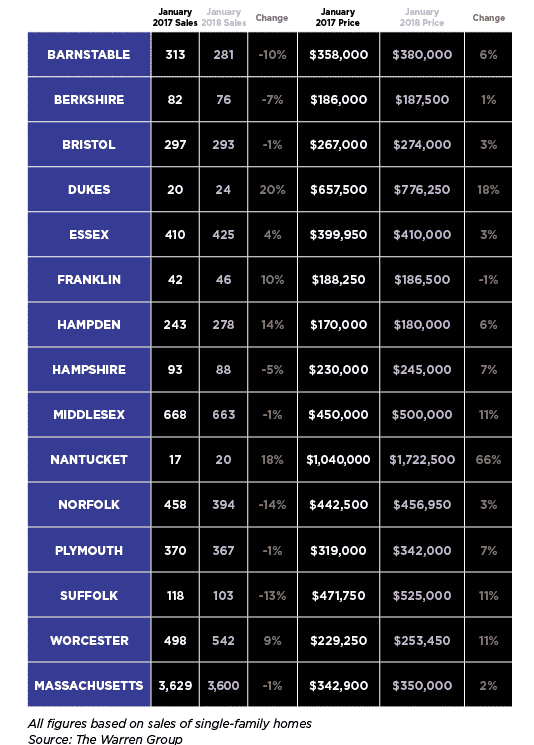The January numbers are in and the spring market has sprung. From the look of things, 2018 is going to make the feverish 2017 market look tepid and continuing to squeeze buyers.
The market has pushed buyers to the edge, said Rich Rosa, broker/owner of Buyers Brokers Only. He has a number of clients who went from looking full time to only checking in with him once or twice a month because so few homes hit the market that meet their criteria and budget.
“Of course, there are still clients who need to move for one reason or another, so they look every week, but I have never had so many clients that only check in periodically; there just aren’t any homes for them to see,” Rosa said.
Though the typical spring rush of new listings is coming online, it hasn’t been enough to satisfy the demand created by six years of declining inventory. There were 9,188 single-family homes for sale in January, according to data from the Massachusetts Association of Realtors (MAR). That’s down 31.8 percent from January 2017, which was considered extraordinarily low at the time.
New listings help, but there aren’t enough of them. There were 3,557 new single-family listings in MLS in January, down 14.3 percent from January 2017. But according to analysis from The Warren Group, publisher of Banker & Tradesman, 3,600 single-family homes sold in January. That drove the median single-family sale price up 2 percent to $350,000, from $342,900 a year earlier.
And homes aren’t just selling for more, they’re selling faster than ever. MAR reports that single-family homes sold in January spent an average of 72 days on the market, down 11 percent from January 2018, when they sold after 81 days.
The condominium trends are similar. According to The Warren Group, 1,444 condominiums sold in January 2018, compared to 1,467 in January 2017, a 1.6 percent decline. The median sale price rose 4.6 percent to $345,000 – the highest January median condo price in Massachusetts’ history. MAR says those condos sold in 61 days on average, same as last year.
“The increased median home price is a good indicator that 2018 could be another record-setting year,” Timothy Warren Jr., CEO of The Warren Group, said in a statement.
Frustrations Rise
Anecdotal evidence from February supports him.
“This time of year, agents are always frustrated because homes are not coming on fast enough,” said market-watcher Anthony Lamacchia, broker/owner of Lamacchia Realty. “It’s worse this year than it was last year, and last year was worse than the year before that.”
It’s still early, but by April or May, buyers are going to get fatigued after searching and unsuccessfully competing for homes, he said.
The expected increase in listings in the coming weeks and months will help, but what’s needed is more construction, according to MAR Director of Communications Eric Berman.
“The answer is more production,” he said. “It’s not enough for people to list their homes for sale. It’s good for the economy and the housing market for transactions to continue to happen.”
 Even if the HOME bill, designed to encourage more housing production, is passed and implemented in municipalities, it’ll be years before it makes a significant impact in the residential real estate market.
Even if the HOME bill, designed to encourage more housing production, is passed and implemented in municipalities, it’ll be years before it makes a significant impact in the residential real estate market.
“For the remainder of this year, the market will continue like this,” said Greater Boston Association of Realtors 2018 president Marie Presti, broker/owner of The Presti Group. “I don’t see it getting better this year. It’s going to take a couple of years for things to change. If interest rates continue to creep up to 5.5 percent or so, some of those buyers might drop out of the market.”
Buyers are increasingly frustrated by how long the process takes, how much they have to spend and how many concessions they have to make, she said, though upfront counselling and buyer flexibility can help.
“I tell them all to try not to get emotional and fall in love with the first house they see,” Presti said. “Don’t expect your first house will be your forever house. I tell them they have to have perseverance and they have to be open to not getting everything they had their hearts set on.”
From a buyer’s perspective, it’s bad enough that bidding wars are driving comps and sales prices skyward, the anemic inventory is forcing rehabbers to look at properties they wouldn’t normally, giving typical buyers even more competition.
And as bad as it is, things can always get worse.
“I saw in the news that Amazon is bringing 2,000 jobs to Seaport, which will help bring more new people in,” Presti said. “That’s more buyers, but on the other hand, I’m hoping they’re just trying before they buy – and if they like it here, maybe they’ll locate their second headquarters here too.”
HQ2 would bring up to an estimated 100,000 jobs to the area and an untold number of would-be homebuyers into the housing market competition at record low inventory levels.







